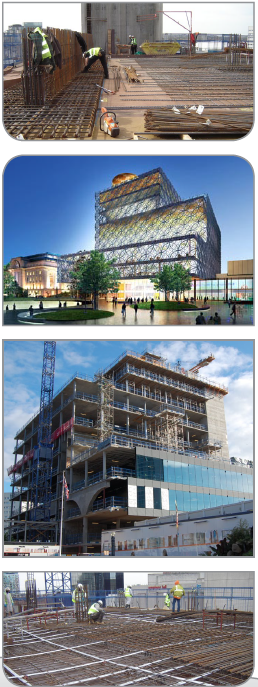 The Library of Birmingham Construction
The Library of Birmingham Construction
Client
Birmingham City Council
Principal Contractor
Carillion
Structural Engineer
Matthew Consultants
Frame Contractor
A J Morrisroe
Post-tensioning Contractor
Freyssinet Ltd
Works Completed
July 2011
Construction of the new The Library of Birmingham was originally conceived as a structural steel frame. During the tender period, and in order to realise the full value engineering benefits, the frame was changed to RC with post-tensioned slabs and beams.
Designed by Francine Houben of Dutch architectural practice Mecanoo, the Library of Birmingham was been designed to be a ‘people’s palace’. Construction started on the library in Centenary Square in 2009, with building works led by Principle Contractor Carillion, with Freyssinet acting as Post-tensioning Contractor.
The building on plan was 52x56m and 10 storeys tall, over 65m high, not including the basement. In general, the floors were 225 and 250mm thick post-tensioned bonded slabs. These spanned 7.5 to 9.5m and carried a variety of live and dead loads. The live load supported was up to 18kN/m2 and the dead load up to 12kN/m2. A common feature on each floor were the down stand fins on the perimeter grids. These were required to stiffen the slabs in the end bays to control deflections, and were chosen to avoid increasing the building weight by using thicker slabs. Overall, the floor to floor heights matched those of the steel solution and presented a cleaner, unobstructed surface for following trades.
A dramatic feature of the building was the 10m cantilever which overhangs the Centenary Square entrance elevation. Behind this cantilever was a 15m back span, the centre of which carries the main perimeter grid from the fifth floor and above. The original steel scheme proposed this structure as a two-storey deep braced truss, the concrete solution adopted elegant post-tensioned arches over a single storey. The arches were chosen not only for their strength but also to mirror the architect’s design language in the elevation.
The arches were installed between the first and second floors. The first floor slab was suspended from the second on steel hangers and the arches enabled the third floor to be built with traditional formwork unencumbered by steel cross braces. Careful consideration was taken in the design of the temporary works to support these arches and the staged transfer of loads. When fully loaded, the arches at the point of transfer moved upwards by 4mm, less than the 6mm predicted. The slender end profile of the arches required the use of Freyssinet C Range multi-strand tendons placed across the top of the arches.
The Library of Birmingham opened to the public in September 2013. It is largest regional library in Europe and the UK’s most visited tourist attraction outside of London. The striking building houses the city’s collections of archives, photography and rare books and provides a setting for a vast range of cultural opportunities, events and exhibitions.
